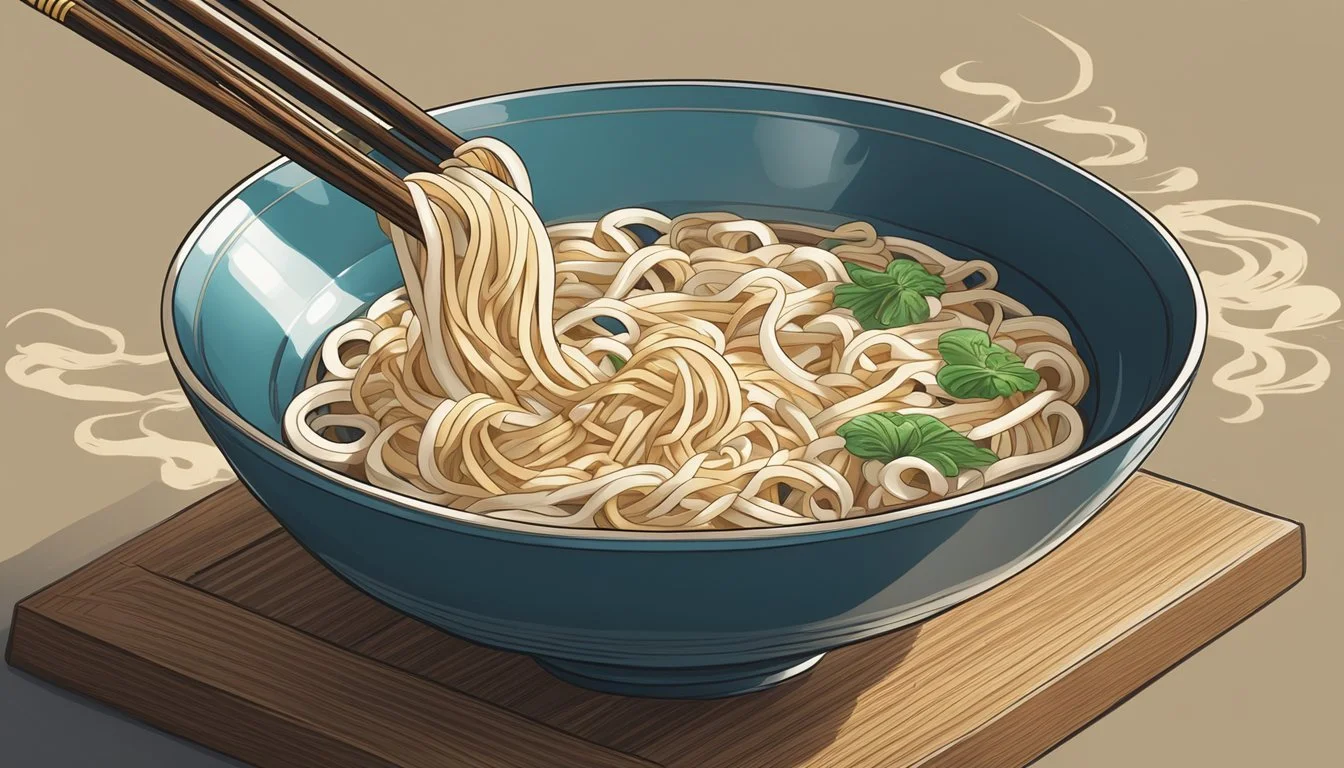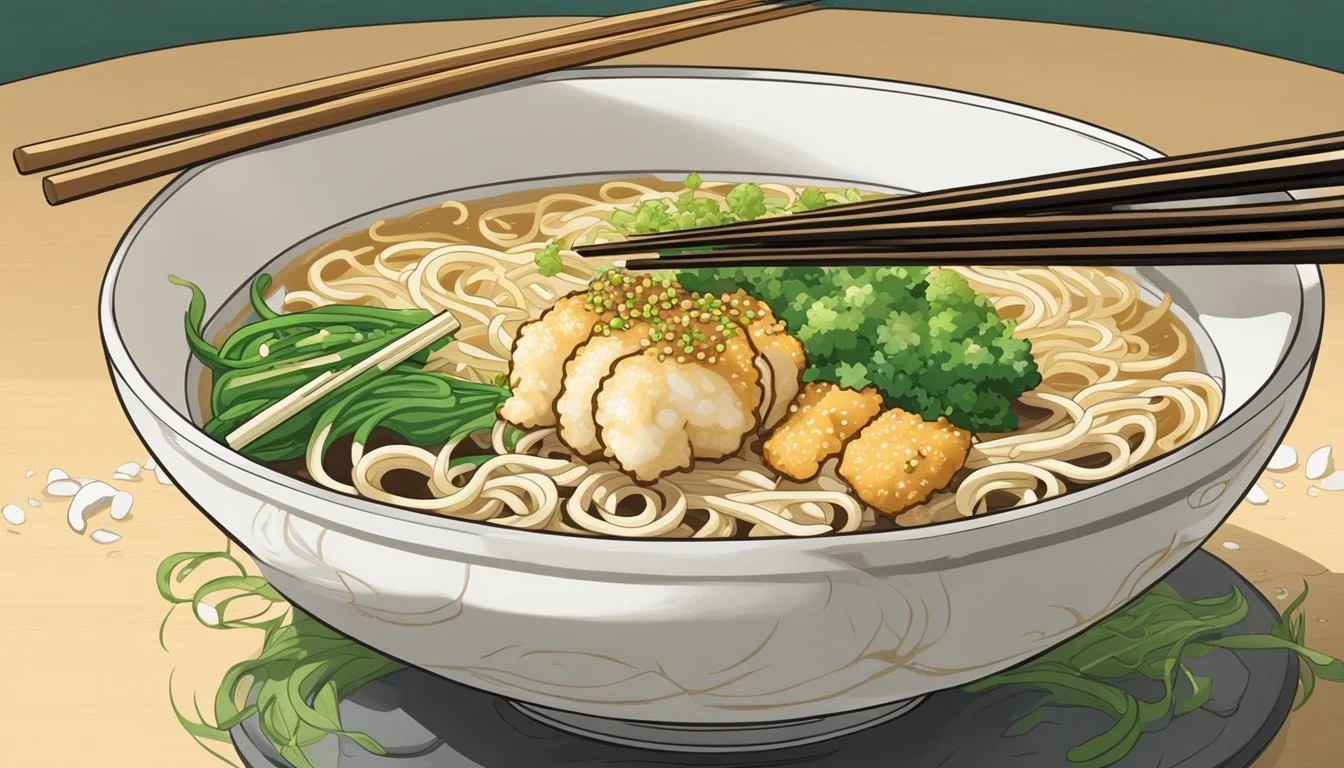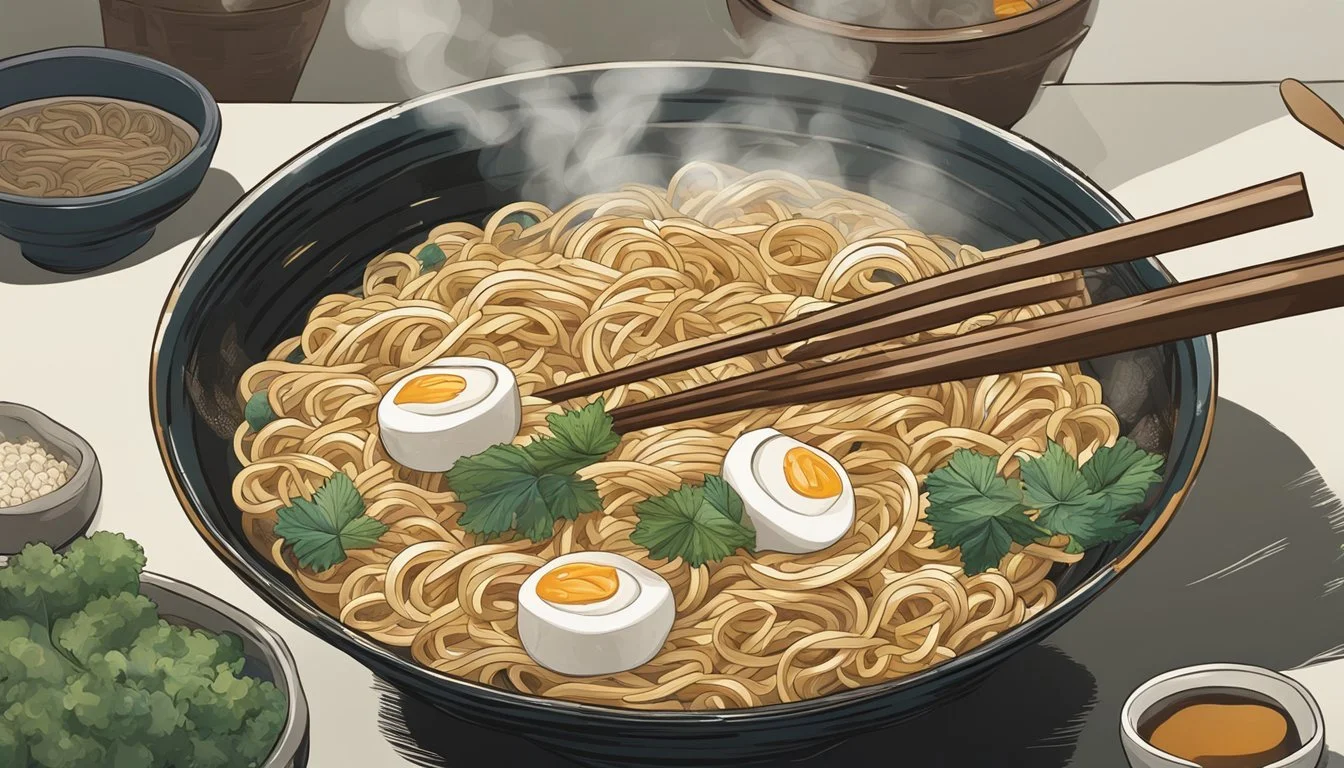How do you eat udon noodles?
Mastering the Japanese Slurping Technique
Udon noodles are a staple of Japanese cuisine with their origins dating back to the 9th century. Characterized by their thick and chewy texture, udon is made primarily from wheat flour. They are traditionally served hot as part of a noodle soup in a mildly flavored broth, or they can be served cold, particularly in the summer, accompanied by a dipping sauce or dressed with a chilled broth.
Eating udon is an experience that combines taste with technique. The noodles are typically enjoyed with chopsticks, and it's customary to slurp them, which is not considered impolite, but rather, expresses the diner's enjoyment of the meal and helps cool down the hot noodles as they enter the mouth. Additionally, the versatility of udon allows it to be included in a variety of dishes, from a simple side seasoned with soy sauce to a hearty main course with proteins like tofu or shrimp.
Health-conscious diners appreciate udon for its nutritional benefits when made from high-quality whole wheat flour. Udon provides a source of complex carbohydrates, which are a critical part of a balanced diet. Unlike simple carbohydrates, they are higher in fiber and digested more slowly by the body, which can be beneficial for weight management and chronic disease prevention.
Historical Background
Udon noodles hold a significant historical position in Japan as a beloved staple, deeply interwoven with the country's culinary culture and regional traditions.
Origin of Udon
The origin of udon noodles is typically traced back to Japan's Sanuki region, now known as Kagawa Prefecture. Historians suggest that udon was likely introduced to Japan from China between the 9th and 12th centuries. Over time, Kagawa Prefecture developed a distinguished reputation for its udon, known as Sanuki udon, characterized by its chewy texture.
Udon In Japanese Culture
Udon in Japanese culture has evolved beyond mere sustenance to become a cultural icon. Each region in Japan may have its unique way of preparing and serving udon noodles, encapsulating local flavors and traditions. In its broader cultural context, udon is often enjoyed at local noodle shops and is a common household dish, reflecting its vast appeal and adaptability within Japanese cuisine.
Types of Udon
Udon noodles offer a surprisingly diverse eating experience based on how they are prepared and served. This versatility is a result of various preparation techniques and regional influences.
Regional Varieties
Sanuki Udon: Hailing from Kagawa Prefecture, Sanuki Udon is famous for its square shape and flat edges. It's known for its firm texture and is often served in a simple broth to showcase its quality.
Inaniwa Udon: Originating from Akita, Inaniwa Udon is thinner than typical udon, hand-stretched, and known for its smooth, refined taste. It is usually served cold.
Mizusawa Udon: From Gunma Prefecture, Mizusawa Udon stands out with its translucent appearance and is ranked as one of the three most exquisite udon in Japan.
Fresh Vs Dried Udon
Fresh and dried udon vary significantly in texture and cooking time:
Fresh Udon: Typically has a soft and chewy texture and requires less cooking time.
Dried Udon: Can be stored for longer periods and has a firmer bite once cooked. It needs to be boiled for a longer time to reach optimal tenderness.
Other Udon Variations
Udon noodles come in several other variations, influenced by the way they are served:
Hiyashi Bukkake Udon: Chilled udon noodles served with toppings like green onions or grated daikon radish and a concentrated dipping sauce.
Kamatama Udon: Hot udon served with a raw egg and either soy sauce or tsuyu, mixed in to create a creamy sauce.
Salad Udon: A cold dish featuring chilled udon noodles topped with fresh vegetables and a light dressing.
Cooking Techniques
When preparing udon noodles, strict adherence to proper cooking techniques ensures the ideal texture and flavor. These noodles require a balance between finesse and timing to achieve their characteristic chewiness.
Preparing the Noodles
Udon noodles can be purchased either fresh or dried. Before boiling, they should be appropriately separated to prevent clumps. For fresh udon, one must be gentle to preserve their integrity, while dried udon often benefits from a slight hand kneading to help them loosen up.
Boiling Method
To cook udon noodles, bring a pot of boiling water to a rolling boil. Fresh udon typically cooks faster than dried, so it’s important to consult the packaging for specific times.
Add the noodles to the pot.
Stir gently to prevent sticking.
For dried noodles, once they've returned to a boil, add cold water to the pot and bring back to a boil to ensure even cooking.
One must taste the noodles to ensure they're fully cooked—seeking a soft yet chewy texture. Drain the noodles and rinse under cold water to halt the cooking process, preventing a mushy consistency.
Traditional Serving Styles
Udon noodles are versatile in their preparation, often presented in either warming hot dishes during cooler months or refreshing cold dishes as a summertime comfort.
Hot Udon Dishes
Kake Udon is a quintessential hot udon soup dish. It consists of udon noodles served in a simple soy-based broth, often garnished with thinly sliced scallions. The broth is typically made from dashi, soy sauce, and mirin, offering a balance of flavors that complement the chewy texture of the noodles.
Nabeyaki Udon is another popular hot udon dish. This is a one-pot meal with udon noodles in a rich broth, served with a variety of toppings such as tempura, egg, and vegetables, providing a hearty and satisfying experience.
Cold Udon Dishes
Zaru Udon features chilled udon noodles that are typically served on a bamboo mat known as a zaru, making for a cool and delightful dish. Diners dip these cold, firm noodles into a chilled dipping sauce, or tsuyu, which has a similar flavor profile to the hot udon broth but with a stronger intensity due to its concentrated nature.
Su Udon, also known as Hiyashi Udon, is an alternative cold dish where the udon noodles are served in a cold soup or broth. Toppings may include grated ginger, myoga, and green onions, which add a refreshing contrast to the chilled and smooth udon noodles.
Udon Ingredients
Udon noodles are a staple of Japanese cuisine, primarily made from wheat flour and often accompanied by a flavorful broth and various toppings. Understanding the components that make up udon is essential for appreciating this dish.
Dashi and Broth
The foundation of any udon dish is its broth, typically made from dashi, a rich stock that imparts umami flavor. Dashi is commonly concocted using kombu (dried kelp) and sometimes includes shavings of smoked bonito fish, although there are vegetarian options that omit fish products. The broth is seasoned with soy sauce, which provides a salty and savory taste, and mirin, a sweet rice wine, balancing the overall flavor profile.
Basic Dashi Ingredients:
Kombu (dried kelp)
Bonito flakes (optional for vegetarian dashi)
Water
Broth Seasoning:
Soy sauce: for savory depth
Mirin: for subtle sweetness
Salt: to taste
Toppings and Fillings
Udon can be customized with a variety of toppings and fillings to enhance its taste and texture. Common toppings include thin slices of meat such as pork or beef, tofu, and a variety of vegetables like green onions or scallions. In addition, some dishes feature tempura, deep-fried seafood or vegetables, providing a delightful crunch.
Protein Options:
Sliced beef, pork, or chicken
Tofu: soft or fried
Vegetables and Garnishes:
Green onions/scallions: finely chopped
Tempura: assorted seafood or vegetables
Other Toppings:
Egg: beaten and poured into the soup or hard-boiled
Flour: additional wheat flour may be used to dust tempura
Udon's versatility allows it to cater to diverse palates, with ingredients ranging from simple garnishes to more elaborate toppings, each contributing to the sensory experience of the dish.
Udon in Modern Cuisine
Udon noodles have woven their way into modern culinary practices, finding their place in both traditional and innovative dishes. They bring a satisfying texture and versatility to the table, which chefs around the world use to craft creative and appealing meals.
Fusion and Innovative Dishes
Udon's adaptability allows it to be a prime candidate for fusion cuisine, creating dishes that blend Japanese tradition with international flavors. For instance, Yaki Udon—stir-fried udon noodles—is often combined with a variety of proteins like chicken, beef, or tofu, infusing it with iron and fiber. Adding a twist, some chefs incorporate ingredients like kimchi or Italian herbs, offering a unique and unexpected dining experience.
Another burgeoning trend involves Curry Udon, a heartwarming dish that is a blend of thick wheat noodles and rich Japanese curry, often laden with meat or vegetables, providing a robust meal that satisfies a range of taste preferences.
Udon Pairings and Side Dishes
Udon noodles are not limited to main courses but also shine as accompaniments:
Udon Salad:
Served cold, making it a refreshing option during warmer months.
Typically blended with crisp vegetables such as lettuce and tomatoes, and dressed lightly with tsuyu to accentuate the noodles’ subtle flavor.
Side Dish Innovations:
Lightly seasoned with soy sauce and garnished with scallions or sesame seeds for a simple yet flavorful side.
May be combined with a stir-fry of vegetables, offering a balance of textures that complements the main protein of a meal.
Modern cuisine respects udon's origins while also embracing new interpretations, solidifying its role as a versatile and beloved ingredient in contemporary kitchens.
Eating Udon
Eating udon is an exercise in simplicity and tradition. Mastery involves proficient use of utensils and an understanding of the cultural etiquette that accompanies this staple of Japanese cuisine.
Utensils and Techniques
When consuming udon noodles, one primarily uses chopsticks. The technique is straightforward: one separates a manageable bundle of noodles from the rest, then uses the chopsticks like tongs to pick them up. Since udon noodles can be slippery due to their boiled and often glossy nature, it is crucial to grasp them firmly to prevent them from escaping the chopsticks. For udon served in broth, a spoon may also accompany the chopsticks to enjoy the soup once the noodles are consumed.
Picking up noodles: Bundle, grasp firmly with chopsticks.
For broth: Use a spoon to sip the soup.
Cultural Etiquette
In Japanese dining, slurping noodles is not only acceptable but also considered part of the experience, helping to cool the noodles and enhance their flavor. When enjoying udon, one lifts the noodles with chopsticks, bites off a piece, and slurps modestly. The sound created by slurping is a sign that one is enjoying the meal and is not considered rude. It's fine to lift the bowl to one's mouth to consume the broth directly, especially when eating udon in a more casual setting.
Slurping noodles: Acceptable, helps cool noodles.
Consuming broth: Acceptable to bring bowl to mouth.
Udon Variations by Consistency
Udon noodles are celebrated for their texture and consistency, which can vary from chewy to soft and come in different shapes such as round or flat. These variations contribute to the unique experience of each udon dish.
Chewy Vs Soft Udon
Chewy udon is notable for its elastic and springy texture, providing a satisfying resistance to the bite. It’s often achieved through a meticulous kneading process and can be accentuated by serving the noodles in a hot broth, which maintains their firmness. On the other hand, soft udon has a more tender bite and may be preferred by those who enjoy a smoother, less resistant texture. This consistency can be found in dishes where the noodles have been simmered in broth for an extended period, allowing them to absorb the flavors and soften.
Thick Vs Thin Noodles
Thick noodles: These are typically rounder and provide a bold, chewy texture that is heartier in a meal. They are synonymous with classic udon noodles, often seen in hot soups where their substantial body is prized.
Thin noodles: While less common, thin udon noodles exist and offer a lighter consistency with a slightly quicker cooking time. These may come in both round or flat shapes and are particularly good in stir-fries or chilled dishes, where they can absorb sauce without dominating the dish.
Accompanying Beverages
When enjoying udon noodles, selecting an appropriate beverage can enhance the dining experience. Traditional Japanese drinks are preferred, considering they complement the nuanced flavors of udon.
Warm drinks offer a soothing balance, especially with hot udon dishes. A popular choice is green tea, which provides a subtle bitterness that can cleanse the palate between bites of the savory noodle dish. The antioxidants in green tea can also offer a feeling of wellness alongside a hearty meal.
For those preferring a cooler beverage, iced green tea maintains the refreshing qualities of its warm counterpart, without overshadowing the udon’s taste. It can be especially pleasing with chilled udon varieties like hiyashi bukkake udon.
Sake, a traditional Japanese rice wine, is another fitting option. It can be served either warm or cool, depending on the season and personal preference. When selecting sake to accompany udon, one might consider a dry variety to offset the richness of the broth or toppings.
Below is a quick reference guide for udon beverage pairings:
Udon Type Suggested Warm Beverage Suggested Cool Beverage Hot Udon Green tea - Cold Udon - Iced green tea Udon with broth Green tea Dry sake
In any case, the beverage should not overpower the udon; rather, it should provide a harmonizing backdrop that allows the flavors of the udon to stand out.
Health and Nutrition
Udon noodles offer a distinct nutritional profile that contributes to an individual's daily dietary needs. They are primarily a source of carbohydrates and provide limited amounts of protein and fiber depending on the flour used.
Nutritional Information
Udon noodles are traditionally made from wheat flour, water, and salt. Their basic nutritional composition per serving typically looks like the following:
Calories: A standard serving of udon noodles contains approximately 200-250 calories.
Carbohydrates: They are high in carbs, with a serving providing around 40-50 grams.
Fiber: If made from whole wheat flour, udon noodles can contribute to daily fiber intake; however, the fiber content is lower compared to other whole-grain pasta options.
Protein: Typically, udon noodles have about 6-10 grams of protein per serving.
Fat: They are low in fat, often containing less than 1 gram per serving.
These noodles also contain small amounts of minerals such as iron but are not significant sources of vitamins unless fortified. Consuming udon made from high-quality whole wheat flour can be beneficial, providing a source of complex carbohydrates that the body digests more slowly compared to simple carbohydrates.
Storing Udon
Proper storage methods for udon noodles are essential to maintain their quality and extend their shelf life. There are two main ways to store udon: preserving them fresh or by freezing and drying.
Preserving Fresh Udon
Fresh udon noodles should be kept in the refrigerator, where they will retain optimal freshness for 3-5 days. They must be placed in a sealed container or wrapped securely to prevent exposure to air, which can dry them out and affect their texture.
Freezing and Drying
For longer storage, one can opt to freeze udon noodles. When placed in the freezer—either in an airtight container or heavy-duty freezer bags to ward off freezer burn—udon can last for up to three months. Drying udon is another method to preserve them, and dried udon noodles can be stored for over three months as long as they are kept in a cool, dry place away from direct sunlight.
Conclusion
Udon noodles are a cornerstone of Japanese cuisine, characterized by their thick, chewy texture. They are traditionally made from wheat flour and can be served in a variety of ways. Whether one chooses to savor them hot in a savory broth or enjoy them cold, complemented by a dipping sauce, udon offers a versatile dining experience.
Hot Udon: Often paired with a warm broth, typically dashi flavored with soy sauce and mirin. Toppings may include thinly sliced scallions, tempura, or a soft-boiled egg.
Cold Udon: Served with a chilled dipping sauce or dressed with vinaigrettes, ideal for warmer months.
In terms of preparation, chefs recommend boiling udon noodles until they are tender yet retain a slight bite. For optimal taste, they should be swiftly rinsed under cold water after boiling to remove excess starch and halt the cooking process.
Accompaniments can enhance the dish:
Proteins: Such as tofu, tempura prawns, or chicken.
Vegetables: Including mushrooms, carrots, and nori seaweed.
Seasonings: Sesame seeds, chili flakes, or ginger for added flavor.
Udon's distinct qualities and the comprehensive approach to serving them — from the noodle's texture to the selection of toppings and broths — cater to diverse palates and occasions. Their straightforward preparation and adaptable nature make them an appealing choice for both traditional Japanese meals and contemporary culinary exploration.










